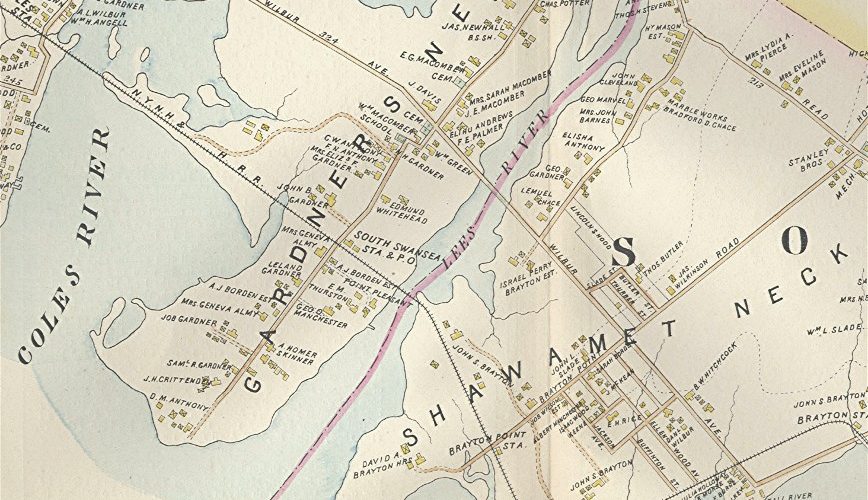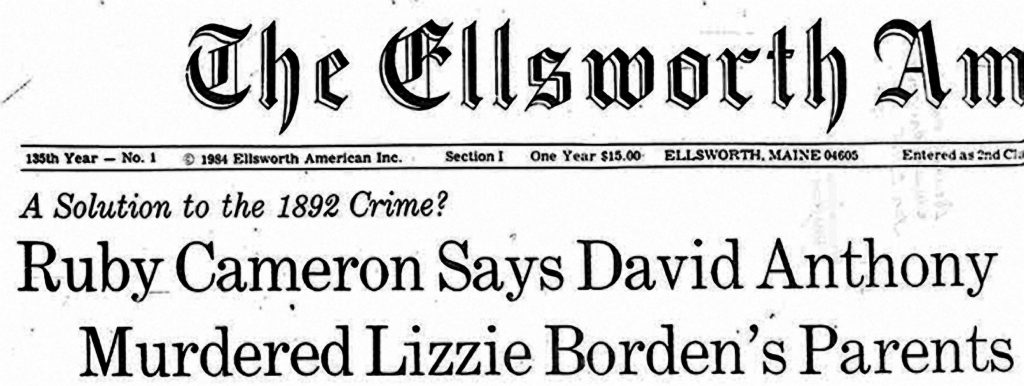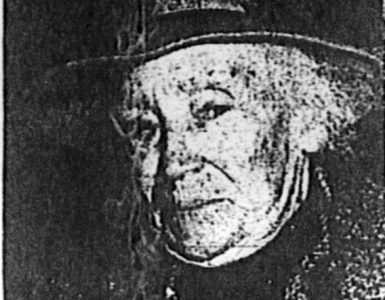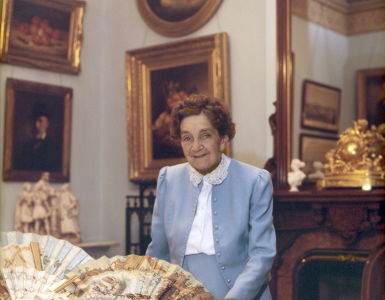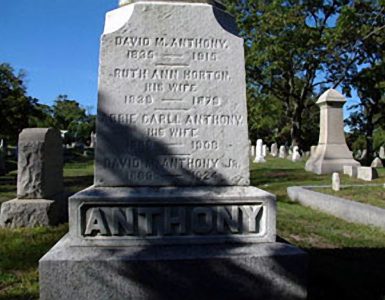by Diana Griffiths
First published in October/November, 2004, Volume 1, Issue 5, The Hatchet: Journal of Lizzie Borden Studies.
Over one hundred years ago, Lizzie Borden was tried for the brutal murders of her father and her stepmother. She was acquitted. Yet, to this day, Borden devotees continue to speculate about who committed the crime. Some still feel Lizzie did it and got off scot-free, while others suspect either: John Morse, the visiting uncle; Emma Borden, the vacationing sister; Billy Borden, the alleged illegitimate son; Bridget Sullivan, the live-in maid; or conspiratorial combinations of the above. Many pages have been written and many theories mounted involving these and other suspects.
Reporter Edwin Porter covered the famous Massachusetts trial in 1893 and wrote a book about it that same year. In 1967, author Victoria Lincoln retold the story from the perspective of a Fall River resident who grew up hearing about the Borden tragedy. And amazingly, almost a century after the crime, a retired nurse living in Cherryfield, Maine contacted the media to say she had heard the true story from Lizzie Borden herself.
In January 1985, at the age of 85, Ruby Frances Cameron contacted the press with the revelation that David M. Anthony Jr., son of a wealthy Fall River family, hacked Abby and Andrew Borden to death that long-ago morning in 1892—and furthermore—Ruby’s own parents had aided and abetted him. At the time of the murders, Ruby relates, her parents were engaged to be married and her mother, Maggie Jonsson, worked as a maid in the Anthony household while her father, John Cameron, drove a wagon for David M. Anthony Sr.’s meat packing company. Miss Cameron said she heard bits and pieces of the story from her mother over the years, and that Lizzie Borden confirmed it when Ruby nursed her during her final illness.
According to Ruby, David Anthony Jr. grabbed an axe from the woodshed and murdered the Bordens in a fit of rage because they refused to accept an ongoing romance between David and Lizzie. In a panic, the Borden maid then ran to the Anthony home and Ruby Cameron’s mother and father came to help with the clean up and to take David away from the scene.
For those knowledgeable about the Borden crime, there are definite sticking points in Ruby’s account. One is when she is quoted as saying that the Borden maid who witnessed the crime and helped with the cover-up was named Nora Donahue. Ruby told Jack Wiggins, a reporter for The Ellsworth American: “Nora Donahue worked in the Borden home as Lizzie’s maid. She came from Ireland and had only been in the United States for six months.” Later she apparently wrote the same paper to say that “Nora saw David, livid with rage, go to the woodshed, grab the axe, and murder both Mr. and Mrs. Borden. Nora rushed for Maggie [Jonsson], and she called Jack, and they wiped up some of the mess and escaped in the meat cart” (excerpt from Ruby F. Cameron letter published in the New Bedford Sunday Standard-Times, January 13, 1985). But county records, trial testimony, and police reports at the time of the murders clearly show the name of the Borden’s maid was Bridget Sullivan, and that she had been in the country for some years prior to her employment with Andrew and Abby.
Ruby also said that, along with David Anthony, her father quickly took both her mother and the other maid away from the scene of the crime. And further, that her mother and ‘Nora’ lived close to each other for the rest of their lives. Obviously, Bridget Sullivan was very much in evidence at the Borden house immediately after the murders—and records show she moved away from the Bristol County area soon after the 1893 trial. Discrepancies like this are never reconciled in Ruby’s tale. Ruby is quoted (i.e. her exact words appear to have been used) as saying the Borden maid was Nora Donahue. One reporter, perhaps realizing Nora Donahue could not have been the Borden maid, suggested she was the Anthony’s maid. But most Bordenites feel Ruby simply misremembered the name of the Borden maid, and that her ‘Nora Donahue’ is actually Bridget Sullivan. After all, where is Bridget in Ruby’s narrative if she is not Nora?
During the few weeks Ruby’s account appeared in the news, it shifted slightly. The Ellsworth American (January 3, 1985), quotes her as saying: “David went out and picked up an axe in the back of the shed and came in and destroyed both of them before anybody could say boo! It was done in a fit of anger.” The implication here is that the murders of Andrew and Abby Borden happened almost simultaneously. Yet on January 27, 1985, she told the Boston Herald that Lizzie told her: “I watched David go absolutely crazy. He killed my step-mother, waited until father came home and killed him.” So now that crucial time gap between the murders has come into play. Also, Ruby originally told the Ellsworth American that she did not nurse Lizzie—that her mother would not allow her to do so—but later, she wrote the same newspaper to say that she did care for Lizzie for a week in 1927.
With variations such as these, it was perhaps not surprising that Florence Brigham, then curator of the Fall River Historical Society, dismissed Ruby’s entire story as fiction. And confronted by Ruby’s claim that David Anthony slaughtered the Bordens, his niece Ruth Anthony Waring was disbelieving, to say the least. She remembered her uncle fondly as a gentle, retiring man and said she had never heard anyone suggest he had any connection at all with Lizzie Borden. It also seems unlikely that, in a town where Lizzie Borden’s arrival at church with the family doctor set tongues wagging, David and Lizzie could have conducted a truly secret liaison.
Faced with these kinds of disclaimers, Kate Boylan, a staff reporter for the New Bedford Standard-Times, did some background research. She found old records listing Margaret Jonsson Cameron as a domestic—and an 1892 Fall River City Directory showing that John Cameron lived at 88 Davol Street. This same directory also provided the information that David M. Anthony Sr. owned property on Davol Street from numbers 83 to 89. So a connection between Ruby Cameron’s family and the Anthonys seemed viable. But was there any connection between Lizzie Borden and the Anthonys?
It appears there are links between Lizzie and David that warrant consideration. One is, that in addition to their homes in Fall River, both the Anthonys and the Bordens owned properties in nearby Swansea, and an 1895 map of the Swansea area shows these properties were close to one another. David’s father’s land was just down the road from Andrew’s place. So, in effect, Lizzie and David were neighbors and may have interacted as such. A social note in a local newspaper suggests another possible encounter between the two in the summer of 1892. According to the July 27, 1892 edition of the Fall River Evening News, just ten days prior to the murders Lizzie was vacationing with friends in Blake’s Point, Marion, at the same time as David’s uncle’s yacht, the Mabel F. Swift, visited the area. These indications of proximity suggest Lizzie and David may have enjoyed at least a passing acquaintance.

Yet, Ruby Cameron’s story remains difficult to accept, perhaps because it contains some unlikely premises—such as her suggestion that Andrew’s first wife, Sarah, left Lizzie a very large inheritance, including some textile mills—and a marriage between David and Lizzie was opposed by Abby and Andrew because they feared losing control of this money.
Although any definitive solution to the Borden case risks the slings and arrows of outraged Bordenites, the main problem with Ruby’s story is that it flies in the face of such primary sources as sworn trial testimony. Ruby said that after the Borden’s maid alerted the Anthony household, John Cameron brought Maggie Jonsson to help clean up after the murders and to spirit David Anthony away. Yet not one witness testified they saw two men, two maids, and a meat wagon in the vicinity of 92 Second Street that day. Still, this only goes toward proving a negative—an admittedly impossible task.
However, reconstructing the events of that day based solely on Ruby Cameron’s story does present a challenge. Details are scanty. Miss Cameron admitted her memory was too fragile after all those years to provide concrete information. Consequently trying to establish the truth behind Ruby’s claims is sometimes akin to dealing with quicksilver. Nonetheless, let us explore her claim and try to devise a scenario that has David Anthony killing Andrew and Abby Borden.
Maybe David arrived at the Borden house that August morning just after nine o’clock. Lizzie let him in and he pressed her to approach her family one more time about their relationship. Abby heard their conversation from the guest room, came out on the landing, and demanded that David leave the house immediately. David, wildly enraged by Abby’s continued interference, grabbed a hatchet, rushed upstairs and hacked her to death.
It is difficult to imagine that Lizzie was not sufficiently horrified by this butchery to run screaming from the house. But, because medical testimony indicates that Andrew Borden died approximately an hour and a half after his wife, this particular reconstruction demands that Lizzie remain in the house with David for another ninety minutes or so while they formulate a plan to murder her father in cold blood. Perhaps Lizzie is in shock. Perhaps she adores David and cannot stand to think of him incarcerated. Perhaps the threat of scandal drives all other thoughts out of her head.
Remember though—Lizzie was not the only person at the house at the time of the murders. In order to accept Ruby Cameron’s story, we also have to assume the Borden maid, Bridget Sullivan, was complicit in the cover up. Bridget would not be moved to help because she was fond of Lizzie. Nor would she be worrying about her job. Her employers were dead, and working for Lizzie after what she had witnessed could not have held much appeal. Was money her motivation?
Ruby said the Borden maid went to the Anthony house to get help. Police records show there was only a very few minutes between Andrew’s murder and the initial alarm. Certainly not long enough for Bridget to run from 92 Second Street to the Anthony residence at 368 North Main Street and back—a total distance of approximately one mile—persuade the Anthonys their son had committed one homicide and was planning to commit another, garner the services of John Cameron and his meat wagon, bring back the maids, and help with the clean up. Therefore, presumably David had to cajole Bridget into going to his family for help between the murders and, if so, at some point during that horrific interval, Bridget Sullivan had to know Abby Borden lay dead upstairs and Lizzie and David were lying in wait to do away with Andrew.
Bridget chatted with the Kelly’s maid, Mary Doolan, and was seen by a neighbor, Adelaide Churchill, while she washed the outside windows that morning. Would she have been able to slip away unobserved? Did Lizzie promise her money and vow to give her an alibi if necessary? Was Bridget able to convince the Anthonys that David was in serious trouble and needed help? And did they decide to send servants in their stead so as not to draw attention to David’s role by showing up themselves?
If so, the Anthony family, two maids, and John Cameron knowingly condoned murder—because now John Cameron, Maggie Jonsson, and the Borden maid had to go back to the house and help David erase clues to his part in the death of Abby and Andrew Borden. And aiding and abetting a murderer requires strong motivation.
The Anthony’s motive is clear enough. David was their son. But do the motives of the others hold up as well? Ruby told two papers that Margaret Jonsson Cameron arrived from Iceland just six months prior to the murders—the Boston Herald and the Standard Times. And she also told the Boston Herald that John Cameron “had only been here two years from the British Navy.” But, again there are discrepancies between Ruby’s memory and written records. The 1920 Massachusetts Census for Bristol County indicates that John and Margaret Cameron arrived in the United States in 1884 and 1885 respectively. However, they did not become naturalized citizens until 1895. Could possible threats of deportation be sufficient motivation to involve them in this dreadful act, as Ruby suggested?
Ruby said her mother suffered from alcoholism and depression and finally committed suicide. Maybe these problems were indications of the difficulty she had reconciling her part in the crime. And Ruby said that, when she told Lizzie she was Maggie Jonsson’s daughter, Lizzie also confessed to what really happened. But, if Ruby’s story is true, more than half a dozen people were involved in covering up the crime. Is it possible that all but two carried the secret to their grave? Any conspiracy theory about the Borden case is burdened with this same weakness, however.
The Ruby Cameron story does provide answers to some of the riddles that have entertained Bordenites for years. Lizzie and David probably guessed that Lizzie would be quizzed closely on why she was unaware of Abby’s whereabouts during the period between the two deaths—hence the invention of the famous note. Neither Lizzie’s clothes nor Bridget’s need be bloodied if David was the killer. The weapon could disappear into the meat wagon and be taken away with the murderer. Emma Borden and John Morse may truly have known nothing about the murders until they arrived back at 92 Second Street. And a crazed illegitimate son doesn’t have to be introduced into the picture when a mad prospective son-in-law is the main protagonist. We are still left with the dress burning of course. But perhaps, as Emma staunchly testified, it was simply an innocent act of normal housekeeping.
Still, major issues remain unaddressed by this version of events. Why would the Bordens oppose a union between Lizzie and the scion of a wealthy Fall River family? Was there really a weapon that close at hand for Abby’s unpremeditated murder? Was there not a money trail to Bridget’s silence? Was Bridget canny enough to withstand three separate grillings by seasoned trial attorneys about the ghastly events on that August morning? Is there any record that Ruby nursed Lizzie Borden? Who was Nora Donahue? And, if there was no truth to her story, why did Ruby Cameron make David Anthony the villain of this piece?
Ruby said David often visited Lizzie at Maplecroft years after the murders, taking Ruby with him on his motorcycle. Neither David nor Lizzie ever married. Is it possible to fantasize they had a romantic attachment severely damaged by shared knowledge and the trauma surrounding the murders—yet sufficient affection remained allowing them to resume a friendship years later?
All these questions lack answers. But remember, every scenario mounted so far as a solution to this crime demands speculation. Certain authors require their readers to believe Lizzie was a lesbian, or that Andrew fathered children out of wedlock, or that Lizzie was the victim of incest, before their theories will hold together. Ruby Cameron’s story is yet a different take on what happened that fateful morning—and may be simply one more indicator that the Borden mystery seems forever destined to resemble those boxed jigsaw puzzles found at summer cottages. The key pieces are always missing.
Works Cited
Atlas of Bristol County, MA 1895. Philadelphia: Everts & Richards, 1895.
Boylan, Kate. “Did Lizzie’s Beau Kill Bordens?” New Bedford Sunday Standard-Times 13 Jan. 1985: 1.
Boylan, Kate. “Obscure David Anthony Led a Carefree Life.” New Bedford Sunday Standard-Times 13 Jan. 1985: 10-11.
Boylan, Kate. “Tracking Down the Existence of the Mysterious Lover, Killer.” New Bedford Sunday Standard-Times 13 Jan. 1985: 10-11.
Cameron, Ruby. “‘I Knew the Whole Story from an Innocent Woman.’” New Bedford Sunday Standard-Times 13 Jan. 1985: 11.
14th U.S. Census for Bristol County, MA. January 1920.
Howard, Marjorie. “She Named Suitor as the Killer, Friends Say.” Boston Herald 27 Jan. 1985: 119+.
Rebello, Leonard, Lizzie Borden: Past and Present. Fall River: Al-Zach Press, 1999.
Sullivan, Bernard F. “Tracking the Truth About Lizzie Borden, Maine Woman Tells Why She Thinks She Knows the Real Killer.” Providence Journal-Bulletin 13 Jan. 1985: C2.
Wiggins, John R.“A Solution to the 1892 Crime?: Ruby Cameron Says David Anthony Murdered Lizzie Borden’s Parents.” The Ellsworth American (Ellsworth, ME) 3 Jan. 1895: Section 1.


